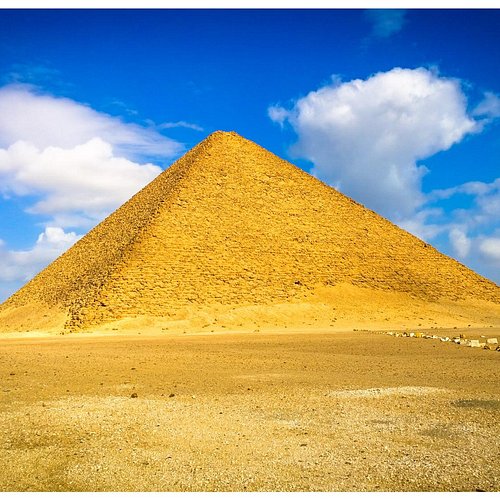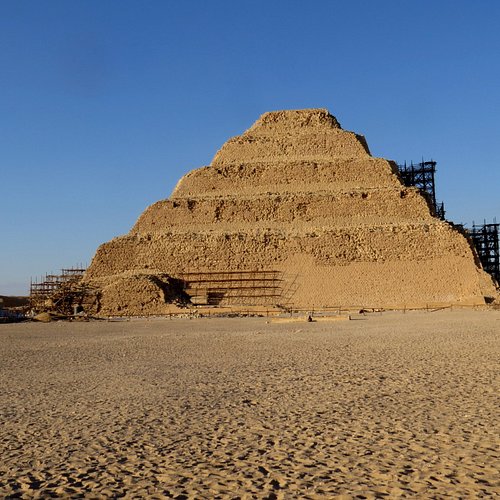What to do and see in Saqqara, Giza Governorate: The Best Ancient Ruins
Discover the best top things to do in Saqqara, Egypt including Tomb of Idut, Niankhkhnum and Khnumhotep's Mastaba, North Pyramid (Piramide Roja), Step Pyramid of Djoser, Serapeum, Mastaba of Mereruka, Mastaba of Kagemni, Mastaba of Ptah-Hotep and Akhti-Hotep, Pyramid of Unas, Mastaba of Ti.
1. Tomb of Idut
Overall Ratings
5.0 based on 10 reviews
Reviewed By Brun066 - Florence, Italy
I had already been - about fifteen years ago - in Saqqara, but I hadn't visited the painted tombs of the royal princes; so this visit was new to me. Princess Shesheshet Idut is one of the five daughters of Unas, traditionally considered the last pharaoh of the V dynasty (and who reigned around the middle of the 24th century BC). With Unas the dynasty would probably end because he had no male children who survived him. The pyramid of Unas, very deteriorated, is a few tens of meters west from this tomb.. The tomb isn't normally open. When we visited it, it was opened by a caretaker, upon payment of an additional entrance ticket. The tomb is made up of a succession of parallelepiped-shaped rooms, all the way to the final room, which ends with the "false door", a communication route between the world of the living and that of the dead. The walls of the rooms bear a memorable series of quite realistic depictions, carved in bas-relief and painted, relating to the sacrifices celebrated for the deceased, to the transport of offerings to the tomb, to scenes set along the Nile or its shores. Historians and archaeologists explain that in the tombs of the Old Kingdom, unlike in later ones, the number of objects of use is limited. On the other hand, many offers to be consumed are transported to the grave: animals still alive, quarters of beef, other foods. Among the scenes that struck me most: those - repeatedly depicted - relating to the bloody sacrifices of the calves: the unhappy animals, tied and still alive, had their legs truncated at the root before (or simultaneously with) the slaughter. Then the naturalistic depictions of the Nile (or even of other water bodies?), featuring different fish species, drawn in detail, and the rich fauna that populates the shores. Finally the dramatic scene - always set in the Nile - of a hippopotamus female about to give birth, while a crocodile, lurking behind her, the mouth wide open, is preparing to swallow the hippo puppy as soon as it comes out completely from the uterus: representation, to what it has been explained to us, of the idea of how faint the boundary between life and death is. To think that these striking and almost intact scenes - of which the Saqqara archaeological site is rich, unlike the Gizah one - date back almost four and a half millennia ago, gives a sort of vertigo, and authorizes me to say that the visit to the tombs painted by Saqqara (among which this one excels) is one of the strongest experiences on a trip to Egypt.
2. Niankhkhnum and Khnumhotep's Mastaba
Overall Ratings
4.5 based on 17 reviews
Reviewed By TravelGipsy - Naples, United States
Thanks to our wonderful guide Hend. We’ve been several times, but never we saw the wonderful places that most tours miss. That is the difference between a great guide!
3. North Pyramid (Piramide Roja)
Overall Ratings
4.5 based on 76 reviews
Reviewed By kaziy - Dhaka City, Bangladesh
The Red Pyramid or the North Pyramid was the third pyramid built by Old Kingdom Pharaoh Sneferu, the father of Khufu, who built the Great Pyramid at Giza. It is the largest of the three major pyramids located at the Dahshur necropolis in Cairo, Egypt. Named for the rusty reddish hue of its red limestone stones, it is also the third largest Egyptian pyramid, after those of Khufu and Khafra at Giza. The Red Pyramid was to be first successful attempt to construct a true pyramid, Much less crowded than Giza and one more thing is that you can enter inside the pyramid. There are three Chambers inside the Pyramid. First two chambers are at ground level, while a third chamber is higher, built within the masonry of the pyramid itself.
4. Step Pyramid of Djoser
Overall Ratings
4.5 based on 585 reviews
Reviewed By ukienomad - Fleming Island, United States
Step Pyramid of King Zoser was built in the 27th century BC. and the beginning of Dynasty 3, possibly the first pyramid Constructed in Egypt. It’s more than 200 feet tall, and the oldest stone structure of its size in the world. The inside of the tombs have murals that provide insights into every day life in ancient Egypt. Be sure to peer into the serdab, a stone structure in front of the pyramid with two eye-holes that invites you to look deeper inside. When you do, you will discover a remarkably life-like painted limestone statue of Zoser looking back at you. An amazing experience to walk through ancient history.
5. Serapeum
Overall Ratings
4.5 based on 43 reviews
Located in Zoser’s funerary complex at Saqqara, this ancient burial chamber was for mummified bulls.
Reviewed By Addicted-to-trips - Cairo, Egypt
The Serapeum is a great tomb that contains so many coffins ⚰️ of animals that were used in ancient Egypt. Some of the coffins are made of granite and some of them are made of basalt. The coffins are so huge and one of them has the well known drawings of ancient Egypt along its wall.
6. Mastaba of Mereruka
Overall Ratings
4.5 based on 44 reviews
Dating back to the 6th Dynasty (2323-2150 BC), this is the largeset tomb complex in Saqqara housing the remains of Mereruka (vizier to King Teti I), magnificent wall paintings, a stone ring for tethering sacrificial animals and a life-size statue of Mereruka walking forward from a false door.
Reviewed By DEK_29 - Brisbane, Australia
This mastaba is situated just outside and slightly down from the Step Pyramid of Djoser. Having 33 rooms, the painting on the walls feature everyday scenes that include, farming, harvesting, fishing and other common folk pursuits. Mereruka was an official in the Old Kingdom during the time of 6th Dynasty pharaoh Teti 1. He had numerous titles including vizier, hence why he mastaba is close to the Pyramid of Teti 1. Some of the original paint work has remained which provides a glimpse into the past of pharaonic Egypt.
7. Mastaba of Kagemni
Overall Ratings
4.5 based on 31 reviews
Reviewed By DEK_29 - Brisbane, Australia
As the son in law and vizier to the sixth dynasty pharaoh Teti, Kagemmi was entitled to a well appointed tomb. the tomb is situated close to the pyramid of Teti itself and displays the everyday life of non-royal ancient Egyptians. Instead of scenes of being the world into balance, war scenes and courting the gods; we see Kagemmi overseeing the planting and growing of grain, hunting animals such as crocodiles and wonderful fishing scenes. The scenes in the mastaba appear as either painted bas relief or two dimensional paintings. The fact that some of the scenes are in bas relief points to the high station that Kagemmi had in life. Free to enter and to take photographs; the Mastaba tomb of Kagemmi is well worthwhile exploring.
8. Mastaba of Ptah-Hotep and Akhti-Hotep
9. Pyramid of Unas
Overall Ratings
4.5 based on 59 reviews
Reviewed By KarenAzinger
Most people visit Saqqara to see the famous Step Pyramid of Djoser, and rightfully so, but while you are there, don't miss out on the Pyramid of Unas. From the outside, this looks like a tumbledown eroded old pyramid, but don't let the outside fool you. This is a pyramid you need to see from the inside. So get your Indiana Jones on and descend the ramp into the heart of the pyramid. You've got to bend over and crouch your way down but it is worth it. The chambers at the bottom are the first to be covered in pyramid text, the earliest version of the Book of the Dead. And the burnished sandstone glows golden in the dim light. This pyramid was a delightful and fun surprise. Don't miss out on the chance to explore the inside of this pyramid!
10. Mastaba of Ti
Overall Ratings
4.5 based on 103 reviews
Reviewed By DEK_29 - Brisbane, Australia
Situated in the necropolis of Saqqara, the Mastaba of Ti is a finely decorated tomb that befits an Old Kingdom official. As an overseer, Ti was able to have a grand tomb that shows life during the Old Kingdom scenes including, daily life, fishing, harvesting of grain and trading. Well worth a visit.










